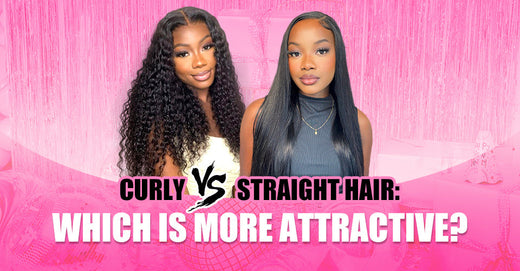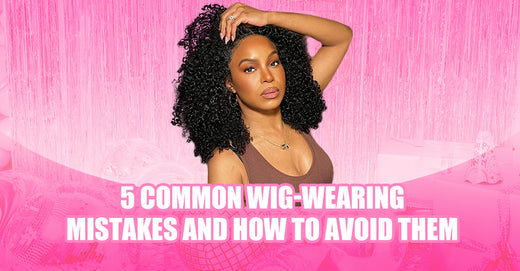Human hair wigs can give you a natural, luxurious look, but over time, they may become frizzy due to heat styling, environmental factors, or lack of proper maintenance. Frizziness can be frustrating, but with the right techniques and products, you can restore your wig to its smooth, shiny self. Here’s how to fix a frizzy human hair wig and keep it looking fabulous.
1. Wash Your Wig Gently
Before tackling frizz, it's important to start with clean hair. Washing your human hair wig properly helps remove any buildup from styling products, oils, and environmental pollutants.
What you'll need:
- A sulfate-free shampoo
- Conditioner designed for human hair wigs
Steps:
- Fill a basin with lukewarm water (never hot water, as it can damage the fibers).
- Add a small amount of sulfate-free shampoo to the water and gently agitate the water to create a lather.
- Submerge your wig in the water, and gently swirl it around. Avoid rubbing the hair, as this can cause tangling.
- After 3–5 minutes, rinse the wig under cool water until the shampoo is completely washed out.
- Apply a generous amount of conditioner to the wig, working it through the strands from mid-length to ends. Allow the conditioner to sit for 3–5 minutes.
- Rinse thoroughly with cool water.
Pro Tip: Never wring out your wig, as this can cause damage. Instead, gently pat it with a towel to remove excess water.
2. Condition and Detangle
Conditioning is key to restoring moisture to dry, frizzy hair. After washing, it's crucial to detangle the wig properly to prevent further frizz.
What you'll need:
- Leave-in conditioner or wig-specific detangler
- Wide-tooth comb or fingers
Steps:
- After gently towel-drying your wig, apply a leave-in conditioner or wig detangler to the damp hair. This helps hydrate the fibers and makes it easier to detangle.
- Use a wide-tooth comb or your fingers to carefully work through any knots or tangles, starting from the ends and gradually working your way up to the roots. Be patient—pulling or tugging on the hair can lead to breakage.
- If you encounter stubborn tangles, apply a little more leave-in conditioner or detangler, and gently work through them.
Pro Tip: Detangle your wig while it’s still damp to avoid breakage. Avoid using a fine-toothed comb, as it can create frizz and cause shedding.
3. Deep Condition for Extra Moisture
If your wig is still frizzy after washing and detangling, a deep conditioning treatment might be in order. Deep conditioning helps restore moisture to dry, brittle hair, making it smoother and shinier.
What you'll need:
- Deep conditioning treatment (look for one with nourishing ingredients like argan oil, keratin, or shea butter)
Steps:
- Apply a generous amount of deep conditioner to your wig. Focus on the mid-lengths and ends, where frizz is often most concentrated.
- Cover the wig with a plastic cap or wrap it in a towel to trap heat and allow the treatment to penetrate deeply into the hair.
- Let the deep conditioner sit for 15-30 minutes, depending on the product’s instructions.
- Rinse the wig thoroughly with cool water to seal the cuticle.
Pro Tip: Deep condition your wig once every 2–3 weeks, depending on how frequently you wear it. Regular deep conditioning will keep your wig soft and manageable.
4. Use Heat Styling Tools with Caution
Sometimes, a little heat can help smooth out frizz, but it's crucial to use the right tools and protect your wig from damage.
What you'll need:
- Heat protectant spray
- Flat iron or curling iron (for human hair wigs, set the temperature to 300–350°F)
Steps:
- Once your wig is completely dry, spritz it with a heat protectant spray. This step helps shield the hair from heat damage and adds shine.
- Using a flat iron or curling iron, carefully smooth out frizzy areas by running the tool through the hair in sections.
- Don’t overdo it—just a few quick passes will be enough to smooth frizz without causing damage.
Pro Tip: Always test a small section of hair with the heat tool before styling the entire wig to ensure that the temperature is set correctly and won't cause damage.
5. Apply a Frizz-Control Serum
Once your wig is styled and dry, applying a frizz-control serum or anti-frizz oil can help seal in moisture and prevent frizz from returning.
What you'll need:
- Anti-frizz serum or lightweight hair oil (such as argan oil or silicone-based serum)
Steps:
- Apply a small amount of serum to your palms (a little goes a long way) and gently run your hands through the wig to smooth down flyaways and frizz.
- Focus on the ends of the hair, as this area is often drier and more prone to frizz.
Pro Tip: Avoid applying too much product, as it can weigh down the hair and make it look greasy.
6. Store Your Wig Properly
How you store your wig can also impact its frizz levels. Storing your wig correctly helps maintain its shape and prevents tangling or frizzing between wears.
What you'll need:
- A wig stand or mannequin head
- A satin or silk wig cap (optional)
Steps:
- After wearing your wig, gently comb through it to remove any tangles.
- Place the wig on a wig stand or mannequin head to maintain its shape.
- If possible, use a satin or silk wig cap to store the wig, as these materials help reduce friction and prevent frizz.
Pro Tip: Never store your wig in a tight bag or container, as this can cause tangling and create unwanted frizz.
Conclusion
Frizzy human hair wigs can be easily tamed with the right care and products. By washing, conditioning, and detangling properly, using heat styling tools with caution, and applying frizz-control products, you can restore your wig to its smooth, shiny state. Proper storage also plays a key role in maintaining your wig’s appearance.
At Reshine Hair, we offer a variety of high-quality human hair wigs that are designed to give you a natural, sleek look. With these simple tips, you’ll be able to fix any frizz and keep your wig looking flawless for every wear. Ready to give your wig the care it deserves? Browse our collection of human hair wigs today!



